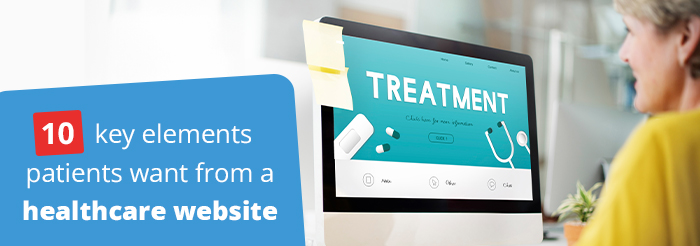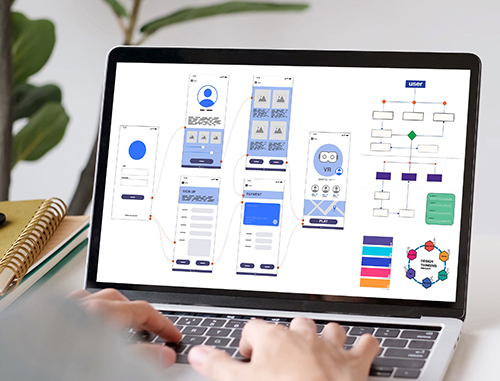10 Key Elements Patients Want from a Healthcare Website
Posted on
More than ever, patients and potential patients are looking for healthcare information online, and if your website is up to date, easy to use, and packed with clear and comprehensive information, you stand to gain traffic, visibility, and customers. But if it is not, you risk not only losing traction in search engine rankings, but also making a bad impression, losing the trust of patients, and turning off new customers.
Websites are complex entities, and they do – or should do – more than just provide a list of services and a way to find key phone numbers. The look and feel of your website may be as important as the way your office looks from the street – you wouldn’t expect a weedy lot with peeling paint to instill confidence in patients, so why would a slow, outdated, or confusing website make patients feel good about the level of medical care you can provide? They are very much the same.
Luckily, meeting the expectations of your customers is not an impossible task. Here are the top 10 elements that patients expect from a medical website, and how you can meet them.

Use a responsive design to ensure mobile accessibility
Years ago, mobile device use surpassed traditional desktop or laptop computer use, and while website design itself is typically done on a desktop unit, it’s critical to keep in mind that most of your visitors will be accessing your website on their phones. This means that healthcare websites must be accessible and functional on smartphones and tablets. A responsive design ensures that the website adapts seamlessly to different screen sizes, providing a consistent and optimal user experience across various devices. Mobile accessibility is not just a convenience; it’s a necessity for reaching a broader audience in today’s mobile-centric world.
Include patient portals for personalized interactions
Patients value personalized interactions with their healthcare providers. A patient portal on a medical website allows individuals to access their health records, view test results, and communicate securely with their healthcare team. It can also help patients to book appointments and pay bills. This feature enables patients to actively participate in their healthcare, saves them time, and prevents a lot of headaches. Plus, patient portals contribute to a more efficient exchange of information between patients and healthcare providers, meaning that in many cases, what would have been a face-to-face visit can be handled with a short, simple email.
Post educational resources and multimedia content
Sure, patients go to your site for phone numbers, addresses, and hours of operation. But beyond that basic information, patients look for and appreciate educational resources that help them to make informed decisions about their health and stay current with trends in medical technology and care options. Top medical websites should include multimedia content such as videos, infographics, and animations to enhance the understanding of complex medical concepts. Educational content helps demystify medical terminology and procedures, making it more accessible and engaging for patients, and offering a way for you to advertise services and treatments to customers.

Promote your security and privacy assurances
Health information is sensitive – not just to regulatory authorities but to patients themselves. Patients prioritize the security and privacy of their data when interacting with medical websites. Your website must comply with relevant healthcare data protection regulations and has to employ robust security measures that safeguard patient information at all costs. Clear and transparent privacy policies should be communicated to reassure patients that their data is handled responsibly.
Include testimonials and patient reviews
Many patients look closely at patient reviews to learn about providers and to get a sense for how other patients like the care and service. This can also extend to reviews of facilities, billing, and more. Including patient testimonials and positive reviews on the medical website can build trust and credibility. It humanizes the healthcare experience, assuring prospective patients that they are in capable and compassionate hands.
Integrate with social media platforms
Social media is now a powerful tool for communication and information sharing, and your patients rely on it for everything from customer reviews to finding out your office’s location and hours. Further, social media sites are quickly becoming as popular for online searching as actual search engines. Patients expect medical websites to be integrated with social media platforms, which will allow them to stay connected and informed. Social media channels provide an additional avenue for healthcare providers to share relevant content, engage with patients, and address queries. These are valuable tools for building an online community and fostering patient-provider relationships.

Regularly update your content
Healthcare is dynamic, and new research, treatments, and technologies emerge regularly. While many patients will search Google to learn about new findings and treatment options, making that information available on your website builds trust and credibility. Patients expect medical websites to provide up-to-date and relevant content. Regularly updating your website with the latest information demonstrates a commitment to excellence and keeps patients informed about advancements in healthcare. Additionally, fresh content contributes to better search engine visibility, helping patients discover the website when searching for health-related information.
Ensure online booking is easy and hassle-free
Seeking medical care is enough of a pain for most people – the last thing you should be doing is making the scheduling process difficult. Patients want and will appreciate easy online appointment booking.
Telemedicine integration for virtual consultations
Telemedicine became a thing during the COVID-19 pandemic, and it’s here to stay. Patients want a platform that permits virtual consultations, allowing them to easily take care of follow-up appointments, routine check-ups, and non-emergency care. A user-friendly interface for virtual appointments and clear instructions on how to access telemedicine services will enhance the accessibility and convenience of your practice.

Interactive symptom checker and decision support tools
Patients often turn to the internet to understand and assess their symptoms. Including interactive symptom checkers and decision support tools on a medical website can be immensely beneficial. These tools guide patients through a series of questions to help them understand the potential causes of their symptoms and provide recommendations for the next steps, such as seeking immediate medical attention or scheduling a routine appointment. While not a substitute for professional medical advice, these tools empower patients to make informed decisions about when to seek care.
Conclusion
Patients want and expect a lot from healthcare practice websites – is yours up to the task? Meeting these expectations not only enhances patient satisfaction but also contributes to building a strong and positive online presence for healthcare providers. By prioritizing clear communication, accessibility, security, and ongoing engagement, medical websites can become invaluable tools in empowering patients to take control of their health. Ensuring these 10 important features are on your website may take a concerted effort, which is where a dedicated healthcare marketing company like Practice Builders can help you build a comprehensive and integrated website optimization plan that helps grow revenue and attract patients.

 What Are the First Steps When Planning a New Websi..
What Are the First Steps When Planning a New Websi.. SEO Strategies to Rank Your Dental Practice
SEO Strategies to Rank Your Dental Practice How AI is Driving Patient Engagement and Revolutio..
How AI is Driving Patient Engagement and Revolutio..